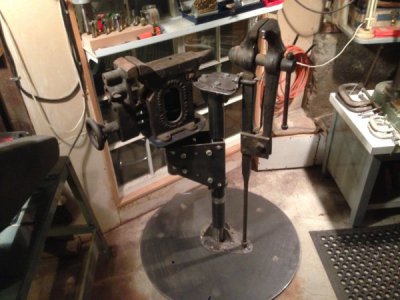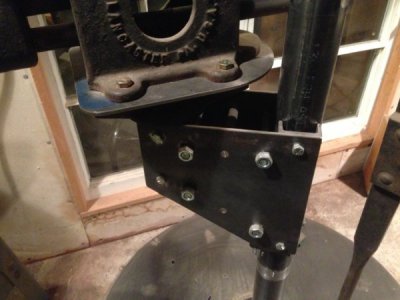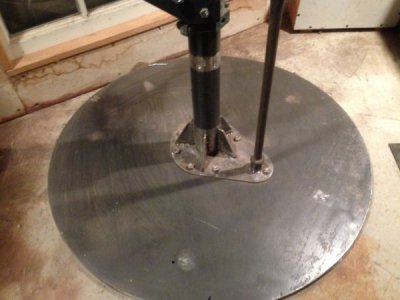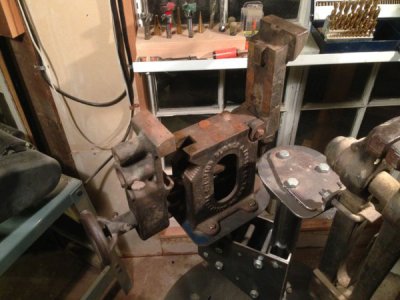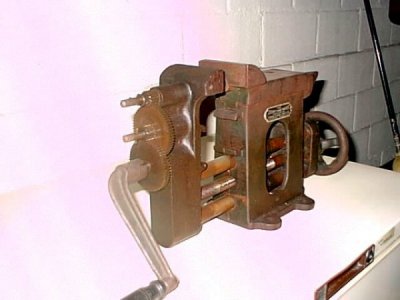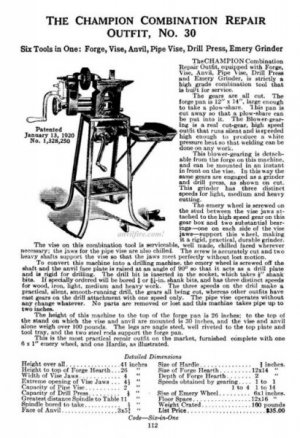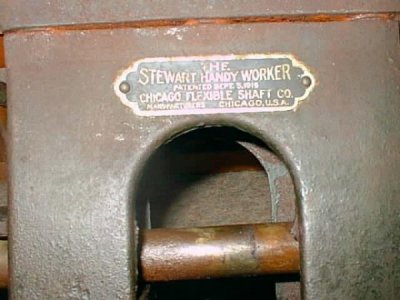R
Robert LaLonde
Forum Guest
Register Today
Now I have to admit I'm a little bit influenced by the beast that was made in the video by Make it Exteme, but it got me thinking about putting my two main vises on a stand or stands. I've got an old Columbian Vise (bench mounted press as we are fond of calling them LOL) mounted to a heavy steel work bench, and a Harbor Freight double swivel vise mounted to my heavy butcherblock work bench. I don't use them often, but when I do they are invaluable. There are two problems. When I am not using them they are in the way and take up valuable bench space. Not just the space where they sit, but the space behind them as well. Then there is the other problem. When the bench is in use (always) there isn't always room to take advantage of the vise easily. Particularly the double swivel HF vise.
I recently made a heavy stand (pedsetal mounted to truck wheel filled with concrete) for my bench grinders, and I was thinking, "how hard would it be to make something like that for a vise?" I know it would either have to be a lot heavier, or it would need to be bolted to the floor. I've got a 6" fiber reinforced slab in my shop (I had it built to park trucks and RVs) so I am sure the floor can take almost anything I can dish out. When I anchored the Hurco mill in place I broke through around 5-5.5inches so I know the contractor didn't skimp on me to badly when they poured the floor. The problem is bolting a stand like that in place is a huge commitment. Like getting married. The alternative is making a heavy stand like the grinder stand, except I know for a fact that the 200lb (apx) grinder stand is way to light for a vise. Even a thousand pounds probably isn't enough when you start levering on something in a vise. ... and if I make a stand that heavy it then becomes almost as much of a marriage as bolting it to the floor. To be fair, neither work bench weighs half a ton, but I can only barely lift one end of the steel one and only by lifting with my legs. I do have a front loader with a 700lb bucket rating that has successfully lifted (a few inches) upto a ton, but its weeps when you do that. Its not something I want to do if there is another option.
I've managed to get by with very few things bolted to the floor of the shop. The walls of the office of course, but the only other thing inside bolted down is the big mill (2+ tons). The smaller mills are all on leveling feet. The big lathe (1 ton) is resting on the floor with shims to level the bed. My manual tire changer did get bolted down, but outside.
So... I wonder if this is a flight of fancy or if there is a way to do this without permanently giving up floor space. I can relatively easily move the grinder stand by tipping it and rolling it, but I suspect that would not be an option with a much heavier stand.
I recently made a heavy stand (pedsetal mounted to truck wheel filled with concrete) for my bench grinders, and I was thinking, "how hard would it be to make something like that for a vise?" I know it would either have to be a lot heavier, or it would need to be bolted to the floor. I've got a 6" fiber reinforced slab in my shop (I had it built to park trucks and RVs) so I am sure the floor can take almost anything I can dish out. When I anchored the Hurco mill in place I broke through around 5-5.5inches so I know the contractor didn't skimp on me to badly when they poured the floor. The problem is bolting a stand like that in place is a huge commitment. Like getting married. The alternative is making a heavy stand like the grinder stand, except I know for a fact that the 200lb (apx) grinder stand is way to light for a vise. Even a thousand pounds probably isn't enough when you start levering on something in a vise. ... and if I make a stand that heavy it then becomes almost as much of a marriage as bolting it to the floor. To be fair, neither work bench weighs half a ton, but I can only barely lift one end of the steel one and only by lifting with my legs. I do have a front loader with a 700lb bucket rating that has successfully lifted (a few inches) upto a ton, but its weeps when you do that. Its not something I want to do if there is another option.
I've managed to get by with very few things bolted to the floor of the shop. The walls of the office of course, but the only other thing inside bolted down is the big mill (2+ tons). The smaller mills are all on leveling feet. The big lathe (1 ton) is resting on the floor with shims to level the bed. My manual tire changer did get bolted down, but outside.
So... I wonder if this is a flight of fancy or if there is a way to do this without permanently giving up floor space. I can relatively easily move the grinder stand by tipping it and rolling it, but I suspect that would not be an option with a much heavier stand.
Last edited by a moderator:



